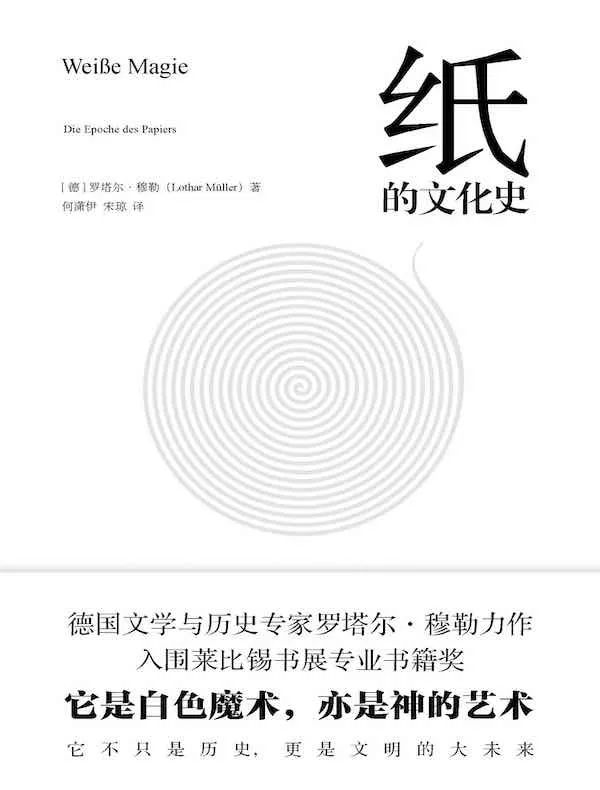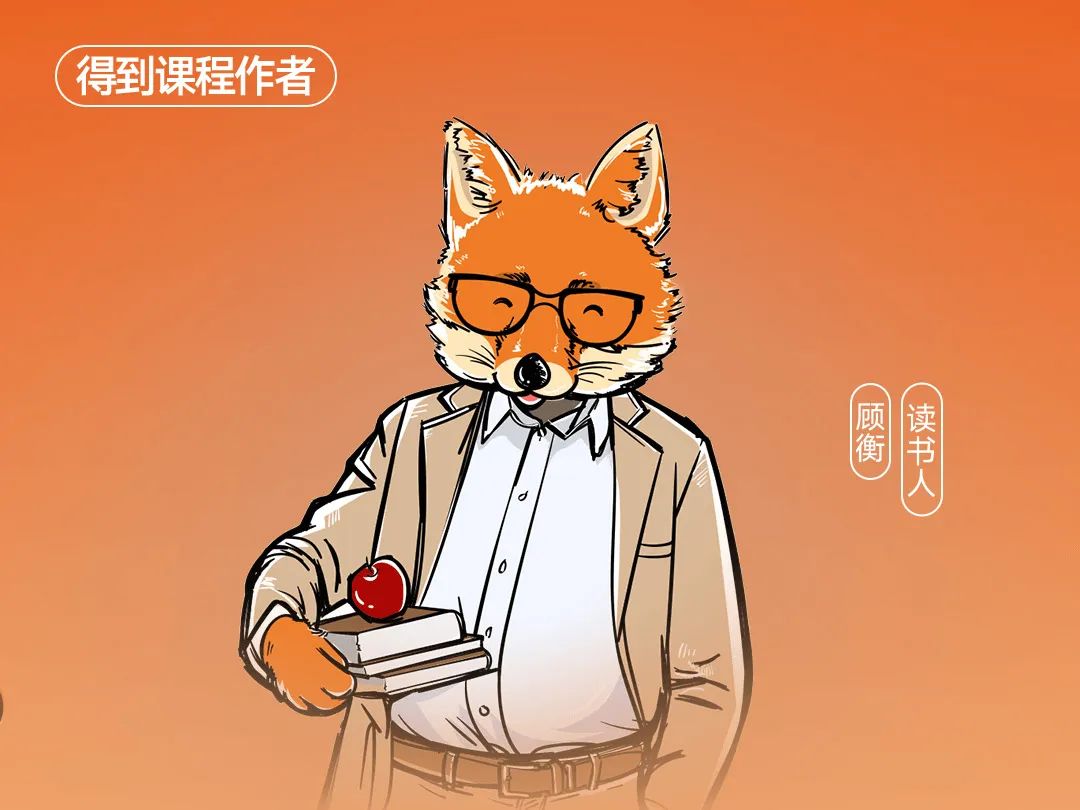
< section >Get a brand new annual daily update column——《Gu Heng Talks about Good Books "Updating.
This new courseis still teaching 50 good books a year, but the difference is that Mr. Gu Heng will not set all the book lists at the beginning, Instead, go to the bookstore every week to find new books to tell you. For the first book in this column, Mr. Gu Heng chose "The Cultural History of Paper". Why did you choose this book to start with? Why can a piece of paper set off a big storm in Europe? Let's take a look at what Teacher Gu Heng said. Click here to join the course< /span>
Hello,I'm Gu Heng. Welcome to"Gu Heng Talks about Good Books". The first book of our column, I chose German literature and historian Rotard ·Mill's"A Cultural History of Paper". 
Click on the picture to read
Why start with this book? McLuhan has a very famous insight: The medium is the message. It means that the medium can not only change the style of the information, but also determine the content of the information. Actually, McLuhan’s idea was inspired by Canadian communication scholar Harold Innis. Innis also said a famous saying: "The emergence of a new medium will lead to the emergence of a new civilization."This sentence Although it is not as popular as McLuhan's "The Medium is the Message", it is really appropriate to use it as the subtitle of Rotar Müller's "A Cultural History of Paper". Paper, this thin plane made of plant fibers, is not just used for writing, it is in the form of banknotes, books, cigarettes, ledgers, playing cards, etc. It has completely changed our way of life. With the popularity of the Internet today, more and more people just use paper to wipe their mouths and buttocks, and the sense of existence of paper seems to be getting lower and lower. However, didn’t McLuhan mention the “rearview mirror principle”? Only through the background of paper fading away, can we understand today's electronic media more clearly and understand our current situation. This is why I chose this book.
The story of the beginning of paper
This book by Mueller, a more accurate title should be "Paper in Europe Cultural History of . He barely touches on the history of the paper before its spread to Europe. So, let’s put his book aside today and let’s talk about the first story of paper. As soon as paper is mentioned, we Chinese naturally think of Cai Lun, saying that as early as 105 AD, Cai Lun invented, or at least greatly improved, the papermaking process. Therefore, art is also listed as the first of the four great inventions in ancient China. In terms of craftsmanship and technology, today's papermaking industry is no longer the same as Cai Lun's period, but the principles used are the same. The rags and plants are smashed to remove impurities and turned into a paste-like thing, and then made into standard-sized planes, and then dried to form paper. Because the raw materials need to be made into a paste in advance, this method is called the pulp paper method. However, if we define paper as a writing surface made of plant fibers, its history starts from ancient Egypt, 3000 earlier than Cai Lun Year, this is the papyrus. The earliest ancient paper discovered so far can be traced back to more than 5,000 years ago. The plant used to make papyrus is called papyrus. The ancient Greeks called this kind of paper and this kind of plant Papyros. Paper in English today comes from this. The original meaning of the word Papyros is "exclusive to the pharaoh", which shows the monopoly and emphasis on paper by the Egyptian royal family at that time. The annual flooding and diversion of the Nile River has created a large number of swamps and wetlands along the river, where papyrus grows, and the tallest can grow to more than 4 meters. This plant is really a gift from heaven to the ancient Egyptians. Its skin is very tough and can be easily torn into strips. The Egyptians not only used it to weave baskets, mats, straw sandals and ropes, but also used this plant to build houses and boats, and even sails were made of papyrus skin. However, our protagonist today is not the outer skin of papyrus, but its inner core. The inner core of papyrus is pure white and the texture is very fluffy. The ancient Egyptians cut it into thin slices, and spread it horizontally and vertically to form two layers. First, it was beaten repeatedly to form a flat surface, and then rolled with wooden sticks. After drying, it became a piece of papyrus. The whole process is like how my Cuihua first made two layers of sliced noodles, and then changed it to rolled dumpling wrappers. How is the quality of the papyrus? Today, many people misunderstand the texture of papyrus, thinking that it is brittle and fragile, and it is not suitable for preservation. But in fact, if Aristotle's "Regime of Athens" was written on Chinese rice paper, it would have been so rotten that there would be nothing left. Because papyrus needs to be beaten repeatedly, its texture is very close to the coated paper we are familiar with today, and it is relatively dense, so Westerners have formed a tradition of writing with hard pens. The ancient Egyptians sharpened the reeds, and then used their teeth to bite the nib like a small brush to write. The ancient Greeks and Romans wrote with a quill pen, and the sharp and hard nib will not scratch the brush. Papyrus paper. As for the Chinese man-made paper, because the pulp is directly scooped on a fine net to filter and dry, there is no process of beating and rolling, so the paper is relatively fluffy and can only be Write with a soft pen, that is, a brush. In addition, the size of the paper also affects the direction of writing. At the beginning, everyone wrote on animal bones or bark, so ancient Egypt, ancient China Either way, they are written from top to bottom, that is, vertical. When the ancient Romans first wrote on papyrus, they were also vertical. Later, the official documents became longer and longer, more than six meters, so they could no longer be read vertically. It can only be changed to write horizontally, but it doesn't work to read a six-meter line horizontally. Da Zhuzi received a love letter from Cuihua, which made him feel like Chaplin screwing a screw, and he had to walk back and forth, which is not ridiculous. So there are columns, and today's newspapers and magazines still continue this typesetting method. Why can papyrus be made so long? Isn't it two layers? You wet the edges of the two sheets of paper, remove a part of the upper layer and the lower layer, and then stick them together, roll them with a rolling pin, and the seams are almost completely invisible. This is another beauty of papyrus. What is written on the papyrus
You may have to ask here, you said that the ancient Egyptians started making paper in 3000 BC and wrote on it. However, the earliest human writing, recognized as the cuneiform script invented by the Sumerians, was in 2500 BC. There was a gap of 500 years, what did the ancient Egyptians write on the papyrus? For this question, compare it with our Chinese oracle bone inscriptions and you will understand. Chinese characters are also derived from pictographic symbols, and the evolution from pictographic symbols to pictographic characters requires an abstract process. At that time, the hieroglyphs of the ancient Egyptians did not have such an abstract process, or if the level of abstraction was not enough, then they could not be counted as words, but could only be counted as talking through pictures . After Sumerian phonograms were introduced into Egypt, it stimulated the transformation of ancient Egyptian hieroglyphs into hieroglyphs. It is conceivable that among the hundreds of symbols, the more commonly used symbols, the higher the chance of obtaining a higher degree of abstraction. Gradually, the writers of ancient Egypt stripped the pictographic meaning of the most common 26 symbols, only let them represent a certain pronunciation, and after further abstraction, Finally the letters are formed. For example, more than half of the 23 letters in the original Sinai alphabet came from ancient Egypt. Who was the first to write on paper? The earliest words written on paper found so far were left by the supervisor of the Egyptian pharaoh Khufu, named Mele, who was responsible for the collection and transportation of stone materials in the construction of the Great Pyramid of Khufu. 4,500 years ago, Mailer drew a table on a piece of papyrus, similar to today's Excel, recording paid and unpaid. The use of writing and paper greatly improved the ruling ability of the Egyptian Pharaoh. Let's still take Mailer as an example: Suppose he only has an abacus, but no pen and paper. Then he can record one result per day at most, but he can't record the process, let alone classify the accounts, which greatly reduces the management level. According to British historian Paul Johnson, administration in ancient Egypt went so far that each department of government had its own font. The county received a red-headed document and looked at it, imitating Song style, from the Ministry of Housing and Urban-Rural Development, regular script, and from the Provincial Office. That's what it means. If there is no convenient writing paper, words can only be carved on stones or written on the wall, such a huge project like the pyramid, which lasted for decades, is unimaginable .
However, in that era, the popularity of papyrus and writing became Curse of the Egyptians. Similar to today, pioneers in innovative industries are always shot dead on the beach. The barbarians don't know a single word, don't talk about martial arts, don't talk about routines, and they can't stand a civilization that is too complicated and exquisite. In today's words, the increase in system complexity must be at the expense of robustness, that is, the shock resistance and stability will deteriorate. This problem was particularly serious in ancient Egypt. One of the most important reasons is that the popularity of papyrus greatly increased the overall funeral expenses of Egyptians. Why did this happen? Because the ancient Egyptians believed that the soul is composed of two parts, Ka and Ba. After death, ka leaves the body and ba remains in the body of the deceased. Only when the two are reunited can the undead be resurrected. Therefore, the Egyptians were willing to spend money on embalming corpses. Actually, the embalming process itself does not cost much. You let a Sichuan lady who makes bacon travel to ancient Egypt, and she can handle it properly. Compared to mummies and bacon, it’s just that there are more cloth strips wrapped around the outside. It is the tomb that really costs money, such as Tutankhamun's tomb. There are many paintings of his own merits and charms on the walls to exorcise ghosts. The poor have no money and cannot engage in such a big battle, but they are unwilling to lie flat. How to do it? He wrote down his own merits and charms of exorcising ghosts with papyrus, sealed them with asphalt, and placed them between the legs of the corpse. This is the famous "Book of the Dead". "Book of the Dead" can only be written by the priests of the temple, because only they know how to deal with the most terrifying monsters, see through the most cunning traps of monsters, and most importantly, Only priests know the correct spell for resurrection. In this way, no matter how poor the poor are, they will ask the priest to write a 30 cm long one. The more money you give, the longer the priest will write. The longest "Book of the Dead" is nearly 50 meters. It is conceivable that this "Book of the Dead" is very expensive. On average, the price of a "Book of the Dead" is equal to half a year's income of a strong laborer. So, how many ancient Egyptians bought the "Book of the Dead"? In the 1500 years before AD alone, 5 million people bought this most common paper product in ancient Egypt. So much wealth was just buried underground. Thick burials lead to a large amount of wealth being concentrated in the hands of the priests. If they really organize an army to fight, they will not be able to pay for it. Egypt was successively conquered by Assyria, Persia, and Rome, and it always lost when it fought with its neighbors. I think it has a lot to do with the premature popularity of papyrus.
Swipe up and down to view the complete class schedule
"Gu Heng Tells Good Books"is currently In the update, Mr. Heng will spend one year explaining 50 good books to help you "read the books well". After the course is over, you will receive a high-quality "Gu Heng Private Book List", covering fields such as society, history, philosophy, and art, and easily complete the annual reading plan. Recommend you to join! Click here to join the course

Click "Looking at" for more My friend and Teacher Gu Heng read the book together
Articles are uploaded by users and are for non-commercial browsing only. Posted by: Lomu, please indicate the source: https://www.daogebangong.com/en/articles/detail/Why%20were%20papyrus%20and%20writing%20a%20curse%20to%20the%20Egyptians.html








 支付宝扫一扫
支付宝扫一扫 
评论列表(196条)
测试